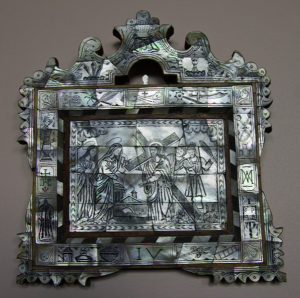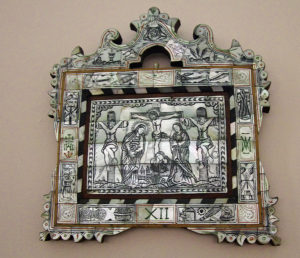The Bar Convent is a very understated dark brick building on Blossom Street, just outside the city wall and close to the railway station. It is the oldest surviving Roman Catholic Convent in England. Just outside the city walls it is away from the usual tourist attractions in York and really is a ‘hidden gem’. It is close to the railway station and has a very good cafe serving reasonably priced food. For early risers, it serves breakfast from 7.45. It also has guest accommodation.
It is an interesting building with a lot of history. There is a small exhibition (£4.50 or £3.50 for concessions) which covers the history of the building and the order of nuns as well as the persecution of catholics. This is mainly display panels, although there are some artefacts. This can probably be missed unless you are really interested in the history. Not to be missed is the chapel on the first floor, which is open daily from 10-5. There are also some attractive gardens at the back of the building – an oasis of quiet.
The full title is the Convent of the Institute of the Blessed Virgin and it was established in 1686, just after the death of Charles II. This was a time of paranoia about catholics and catholicism. The convent was established and operated in secret.
The convent was founded as a school for girls as Sir Thomas Gascoigne, a fervent catholic who declared “we must have a school for our daughters” and provided a gift of £450, for the purchase of land and building. It is a remarkable story of remarkable women, starting with Mary Ward.
Mary came from staunch catholic stock and in 1609 founded an order of religious women modelled on the Society of Jesus. She established communities and schools across Europe. Frances Bedingfield was an early member of Mary Ward’s Institute and signed the lease in a false name, to buy a house just outside Micklegate with the money from Sir Thomas. It was a secret community known as the ‘Ladies at the Bar’ and the sisters wore slate coloured gowns to hide their identity. Discovery meant punishment and even death. The community regularly suffered poverty, persecution and imprisonment.
In 1727, Elizabeth Stansfield joined the convent and paid off the communities debts, demolishing the old house and building a splendid new one with a magnificent chapel carefully hidden from outside view. This had a priest’s hole and eight ways out in case of a raid by protestants. It wasn’t until the First Catholic Repeal Act of 1778 that catholics could openly practice their religion and wear their habits.
During the French Revolution, the community sheltered refugees and priests from France. In the First World War, it provided a home for Belgian nuns and children as well as a hospital ward for wounded soldiers. The community continued to run a school until 1985. The convent is now run as a trust and is still home to Mary Ward’s religious order, the Congregation of Jesus.
The chapel is a lovely light building with pastel coloured walls and flooded with light from the hemispherical windows. At the back is a small wrought iron gallery supported on tall slender columns. The beautiful neo-classical dome is supported by white fluted pillars with gilded capitals. Round the base is a gilded frieze of vine leaves, urns and posies.
The altar is modern, dating from 1969 and celebrating 200 years of the convent. It has scrolled legs with C18th winged cherub heads. In front of it is a gilded pelican from the original altar, pecking her breast to feed her young. Above the C20th reredos are C18th carved figures of Saints Jerome, Ambrose, Augustine and Gregory who support a Spanish ivory crucifix.
The transepts off the chancel are small. The north transept has a small wooden reliquary box, containing the hand of St Margaret of Clitheroe. This is a reare survivor as most saints relics were destroyed in the Reformation. There is a small chapel in the south transept.
Apart from the beautiful building, the other highlight are to beautiful small Stations of the Cross round the walls, made from mother of pearl. They date from the early 1800s and were made in the Holy Land.
This makes a an interesting change from the popular tourist attractions in York. It is very different and well worth finding for the cafe and the chapel. I am very tempted to try the accommodation on another trip to York.
“Website”:http://www.bar-convent.org.uk/
There are more pictures “here.”:http://wasleys.org.uk/eleanor/churches/england/yorkshire/north_yorkshire/york/york_1/bar_convent/index.html









